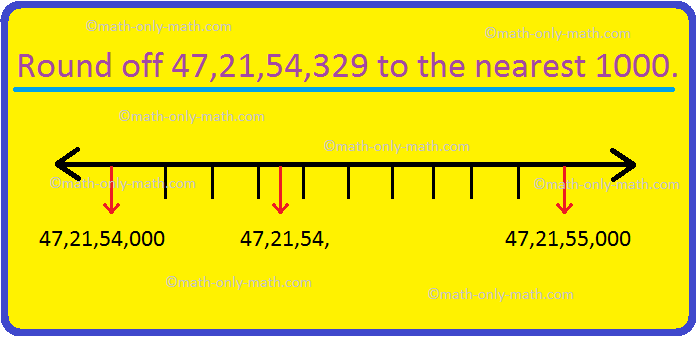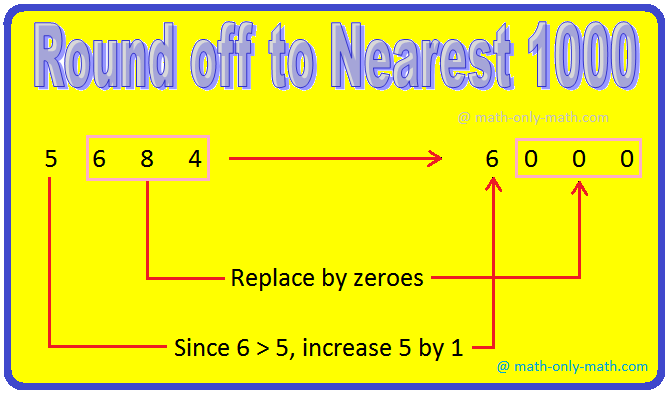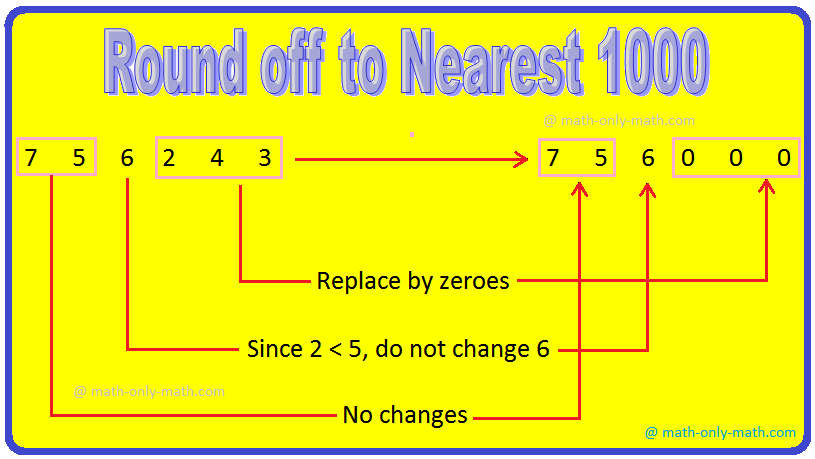Subscribe to our ▶️ YouTube channel 🔴 for the latest videos, updates, and tips.
Round off to Nearest 1000
Round off to nearest 1000 is discussed here.
A large number may be rounded off to the nearest 1000, 10000 and more.
Rules for Rounding off to the Nearest 100o:
Rule I: While rounding off to the nearest thousand, if the digit in the hundreds place is between 0 – 4 i.e., < 5, then the hundreds place is replaced by ‘0’.
Rule II: If the digit in the hundreds place is = to or > 5, then the hundreds place is replaced by ‘0’ and the thousands place is increased by 1.
Round off to Nearest 1000 Video
Subscribe to our ▶️ YouTube channel 🔴 for the latest videos, updates, and tips.
Examples on rounding off to the nearest thousand (1000):
1. (i) 3846 → 4000
We see the digit in the hundred’s place is 8, we round to the nearest multiple of thousand which is greater than the number. Hence, 3846 is nearer to 4000 than 3000.
(ii) 8039 → 8000
We see the digit in the hundred’s place is 0, we round to the nearest multiple of thousand which is smaller than the number. Hence, 8039 is nearer to 8000 than 9000.
(iii) 9985 → 10000
We see the digit in the hundred’s place is 9, we round to the nearest multiple of thousand which is greater than the number. Hence, 9985 is nearer to 10000 than 9000.
(iv) 3500 → 4000
We see the digit in the hundred’s place is 5, we round to the nearest multiple of thousand which is greater than the number. Hence, 3500 is nearer to 4000 than 3000.
(v) 16796 → 17000
We see the digit in the hundred’s place is 7, we round to the nearest multiple of thousand which is greater than the number. Hence, 16796 is nearer to 17000 than 16000.
2. Round off 47,21,54,329 to the nearest 1000.
Solution:
We choose the two multiple of 1000 just greater than and just less than 47,21,54,329 on the number line.
We observe that 47,21,54,329 is closer to 47,21,54,000. So, it is rounded down to 47,21,54,000.
Note: The same procedures are followed to round off large numbers to any place.
Round off to the Nearest Thousand
Step I: Replace ones, tens and hundreds digits by zeroes.
Step II: If hundreds digit is 5 or more then 5, increase the thousands digit by 1, otherwise leave unchanged
Step III: Leave rest of the digits unchanged.
Solved Examples on Round off to Nearest 1000:
1. Round off to the nearest thousand: 5684
2. Round off to the nearest thousand: 756243
3. Round off (i) 6253, (ii) 7923 to the nearest 1000.
Solution:
(i) 6253 is rounded off to 6000 as the digit in the hundreds place is 2.
(ii) 7923 is rounded off to 8000 as the digit in the hundreds place is 9.
4. Round off to the nearest thousand:
(i) 6,07,869; (ii) 2,69,532
Solution:
(i) We have to round off 6,07,869.
Therefore, 6,07,869 is rounded off to 6,08,000.
(ii) We have to round off 2,69,532.
Therefore, 2,69,532 is rounded off to 2,70,000.
Worksheet on Round off to Nearest 1000:
1. Round off the given numbers to nearest 1000.
(i) 72,106
(ii) 1,07,429
(iii) 12,999
(iv) 6,58,854
(v) 38,097
(vi) 7,00,893
(vii) 50,921
(viii) 47,31,129
Answer:
1. (i) 72,000
(ii) 1,07,000
(iii) 13,000
(iv) 6,59,000
(v) 38,000
(vi) 7,01,000
(vii) 51,000
(viii) 47,31,000
2. Round off to the nearest thousand:
(i) 728
(ii) 6780
(iii) 135283
(iv) 24752
(v) 128967
(vi) 24828
Answer:
2. (i) 1000
(ii) 7000
(iii) 135000
(iv) 25000
(v) 129000
(vi) 25000
3. Round off to nearest 1000:
(i) 979
(ii) 1764
(iii) 8287
Answer:
3. (i) 1000
(ii) 2000
(iii) 8000
4. Round 8869 to the nearest thousands
Answer:
4. 9000
5. What is the smallest number which rounded off to the nearest thousand becomes equal to 7000?
Answer: 6500
6. The cost of a house is $3,16,65,880. It was sold at a price rounded to the nearest 1000. At what price was the house sold?
Answer: 3,16,66,000
7. During the Kerala floods, 12,47,809 people were evacuated from their village. If this number was reported in the newspaper after rounding it to nearest ten thousand what figure will appear in the newspaper report?
Answer: 12,50,000
How to round off a number to the nearest 1000?
How to round off a number to the nearest 1000?
Answer
To round off a number to the nearest thousand, look at the digit in the hundreds place.
• If the digit in the hundreds place is 4 or less, then place zeroes in the digit at the hundreds, tens and ones place. Keep the digit in the thousands place as it is.
• If the digit in the hundreds place is 5 or more, then place zeroes in the digits at the hundreds, tens and ones place. Also add 1 to the digit in the thousands place.
- Round off to Nearest 10.
- Round off to Nearest 100.
- Round off to Nearest 1000.
- Rounding off Decimal Fractions.
- Correct to One Decimal Place.
- Correct to Two Decimal Place.
- Worksheet on Rounding off number.
5th Grade Math Problems
From Round off to Nearest 1000 to HOME PAGE
Didn't find what you were looking for? Or want to know more information about Math Only Math. Use this Google Search to find what you need.







New! Comments
Have your say about what you just read! Leave me a comment in the box below. Ask a Question or Answer a Question.